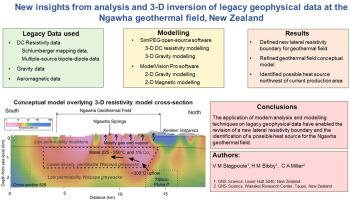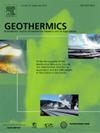来自新西兰Ngawha地热田遗留地球物理数据分析和三维反演的新见解
IF 3.9
2区 工程技术
Q3 ENERGY & FUELS
引用次数: 0
摘要
基于斯伦贝谢直流(DC)、多源双极-偶极电阻率、重力和磁场测量数据的再处理、反演和解释,我们提出了新西兰Ngawha地热田的修正电阻率边界。综合电数据集的三维电阻率反演表明,在Ngawha Springs西北方向约4公里处存在一个深(约2公里)的低电阻率带。这被解释为热地热流体从晚中新世到更新世火山下上升,并通过可渗透的怀帕帕群灰岩向南迁移到恩加华泉的地区。与低电阻率区域具有相似几何形状的重力低被模拟为低密度Waipapa组灰岩(-120 kg/m3),对应于c. 7%的孔隙度,这可能是由于形成地热储层的节缝和大裂缝网络所致。航磁数据模拟表明,在地热系统的西北部存在一个深部弱磁岩体。这与天然气渗漏、温泉和遗迹烧结矿床的出现表明该地区存在地热热源。我们的研究结果表明,现代分析和建模技术可以从遗留的地球物理数据中提取新的信息,从而对Ngawha地热系统的结构产生新的见解。全球地热田的遗留数据需要用现代方法重新解释。本文章由计算机程序翻译,如有差异,请以英文原文为准。

New insights from analysis and 3D inversion of legacy geophysical data at the Ngawha geothermal field, New Zealand
We present a revised resistivity boundary of the Ngawha geothermal field, New Zealand, based on the re-processing, inversion and interpretation of legacy direct current (DC) Schlumberger, multiple-source bipole-dipole resistivity, gravity and magnetic measurements. Three-dimensional (3-D) resistivity inversion of the combined electrical datasets indicates there is a deep (c. 2 km) low resistivity zone c. 4 km northwest of Ngawha Springs. This is interpreted as an area where hot geothermal fluids rise from beneath Late Miocene to Pleistocene volcanics and migrate southward through permeable Waipapa Group greywacke rock to Ngawha Springs. A gravity low with comparable geometry to the region of low resistivity is modelled as a zone of lower density Waipapa Group greywacke rock (-120 kg/m3), corresponding to c. 7% porosity, and is likely due to a network of joints and macrofractures that form the geothermal reservoir. Aeromagnetic data modelling suggests the presence of a deep, weakly magnetic pluton in the northwest part of the geothermal system. This, together with the occurrence of gas seeps, warm springs and relic sinters deposits suggests a geothermal heat source in this area. Our findings demonstrate that modern analytical and modelling techniques can extract new information from legacy geophysical data leading to new insights into the structure of the Ngawha geothermal system. Legacy data from geothermal fields globally, warrants reinterpretation with modern methods.
求助全文
通过发布文献求助,成功后即可免费获取论文全文。
去求助
来源期刊

Geothermics
工程技术-地球科学综合
CiteScore
7.70
自引率
15.40%
发文量
237
审稿时长
4.5 months
期刊介绍:
Geothermics is an international journal devoted to the research and development of geothermal energy. The International Board of Editors of Geothermics, which comprises specialists in the various aspects of geothermal resources, exploration and development, guarantees the balanced, comprehensive view of scientific and technological developments in this promising energy field.
It promulgates the state of the art and science of geothermal energy, its exploration and exploitation through a regular exchange of information from all parts of the world. The journal publishes articles dealing with the theory, exploration techniques and all aspects of the utilization of geothermal resources. Geothermics serves as the scientific house, or exchange medium, through which the growing community of geothermal specialists can provide and receive information.
 求助内容:
求助内容: 应助结果提醒方式:
应助结果提醒方式:


